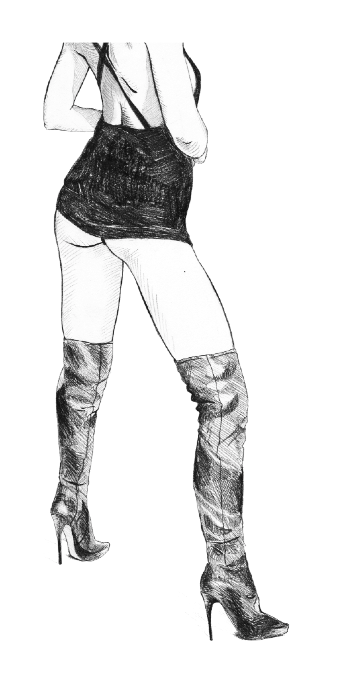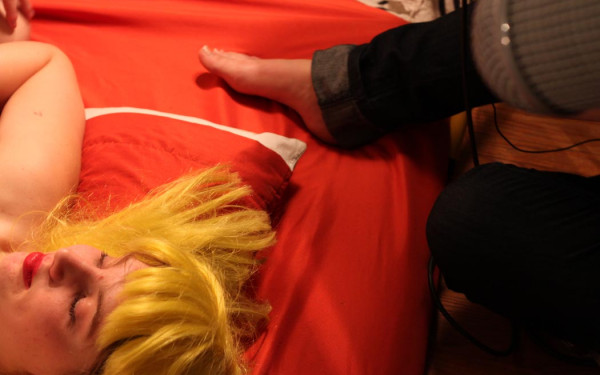Perverse Pleasures
Queer Sex, Kink & Love
“We are all a little weird and life’s a little weird, and when we find someone whose weirdness is compatible with ours, we join up with them and fall in mutual weirdness and call it love.”
— Dr. Seuss
Fetish, kink, freak—whatever you call it, and whatever you feel about it—is actually everywhere.
Permeating our physical bodies, punctuating our pleasures and playing a real part in the power dynamics all around us, kinkiness remains as primal and passionate as we allow it to be—despite science, institutional and social expectations’ attempts to demoralize and shame it out of us.
Of course, historically, certain barriers have been drawn, setting up the notion that “normal” or “natural” sex and love practices exist—as opposed to so-called “perversity” or “deviance.” But it’s obviously not a simple binary.
More than ever before, contemporary sex is about pleasure and recreation rather than reproduction or religion.
The heightened awareness of the transexual and transgender experience also seems to be ushering in a new queer moment where desire and identity dance together.
And there is more information and access than ever.
As the concepts of what is marginal and what is baseline continually evolve, there seems to be an acute awareness these days that what gets us off is as variant and vibrant as the individual.
That said, we’re not as open as we could be; some of the people featured for this piece asked their names be withheld because of the sensitive and sexual nature of the article.
With the spirit of sexy exploration at the heart of our kinky questions, the following interviews were conducted with an intention to explore the people behind the perverse.
Walking the Kinky Line
“Switch” is a 20-something Shibari Japanese rope bondage enthusiast. The fetishism, coupled with the aesthetic and technical elements of restraint, are a real turn-on for her.
“I can’t help but address, first of all, that it’s not perverse to me. I think it’s a natural and intuitive extension of my pleasure,” she said. “There’s a reason why bondage is called bondage- play, or rope-play or fetish-play. That’s the word we use because that’s exactly what you’re doing.
“The bedroom is the last place that we have left to be truly playful. There are pretty strict confines for behaviour in everyday society everywhere else.” Part of the appeal, Switch admitted, is that there is something inherently sexy about being a so-called deviant. “That’s why kinks are kinks,” she said. “Some people have their extreme sports… you need cathartic release somewhere.”
Paradoxically, Switch said that being tied up is where she feels the most free.
“A lot of people into BDSM say the same thing, whether it’s pain or restraint, they feel liberated by it,” she said. “It’s a healthy outlet for our urges.”
Pushing her own limits into the world of love and bondage for the first time just over a year ago, Switch became fascinated by the practice and “crossing an invisible boundary that I realized wasn’t even a boundary to begin with.” But even identifying and sharing her kink has opened her up to the expectations of others.
“You start being asked, ‘Would you do this, or that?’ But that’s not how it works in my mind. I don’t set up the limits ahead of time anymore. I go where the pleasure is. It’s really about the intimate instincts.”
Thirty years ago, people feeling isolated or abnormal about these kinds of instincts would seek medical help far more often than they do today, according to Dr. Laurie Betito, a sex therapist with nearly three decades of experience who hosts a talk radio segment called Passion on CJAD 800.
She rarely sees regular kinksters anymore, but Betito said it’s because they’ve found each other. Our desires, and the desires of others, are as accessible as ever.
“The Internet has changed everything, especially access,” Betito said. “Literally, if you think something you like is a little weird, you Google it and a thousand sites come up where the fetish is the thing. You find your community online, you blog, talk and chat, and suddenly it takes away the stigma.”
In all her experience, the only thing she said psychologists know for sure is that the kinky parts of human sexuality are truly variant and diverse.
“There’s no understanding why one person finds one thing attractive and arousing and another person might find it disgusting,” she said. “Try to explain coprophilia to someone, you know? How could [feces] be arousing? Yet, it is. And there is a bunch of people out there who get off on it.”
Betito said she has seen it all, from bondage and discipline to sadism and masochism, to erotic fantasy, role-playing, polyamoury, nudists, dollification, porn and every fetish you could possibly imagine.
If she had to guess why some fetish has evolved over the years to become mainstream fixtures on MTV while others remain marginal, she’d say communication and exposure—along with our sex-saturated culture and its messages—have something huge to do with the changing attitudes.
There were no hairless crotches in porn thirty years ago, she tells me; today, Betito treats men who can’t imagine having sex with a partner who has a bush.
It’s just one example of how our contact with the carnal defines our culture, she said. “It’s actually changed everything.”
“there are no limits except for our own guilt and fear”
—Switch.
The Mainstream and the Unseen
Montreal Mirror 2011 Noisemaker Esther Splett is a filmmaker—when she’s not working a 9-to-5 job penning screenplays for a mainstream adult content provider.
The young porn writer, who produced the occultist sexploitation short Girls of Prey in 2010, sees a lot of overlap between what she does artistically and for a paycheck. Her films aim to satirize sexual subcultures and walk the line between fetish and excess, arousal and disgust.
“I’m not sure if I have a normal sense, sometimes, about what is accepted or not,” Splett admitted. Sex, for her, is an extreme attempt at communication.
While she’s told her family about her job at the porn plant, Splett said she feels her smutty side has been accepted—as long as she doesn’t begin performing.
“Performing your sexuality for a group of people or a social scene can consume it,” she said, “And anything personal about sex can be erased. That obviously happens in porn a lot, even though I try to address that, but it’s hard because I’m often working within a really rigid mainstream framework.”
Splett explained her work is seen as “cute” to people—as long as she only admits to the writing part of it. “But if I star in it, all of a sudden it’s not so cute,” she explained. “It’s like I should be embarrassed to tell people I’m a porn star, but it’s edgy to say I’m a porn writer. That’s a really big morality line that can be problematic.”
Being sexy “in the wrong ways” is something she said she explores in film, however. Investigating the tensions between what’s hot and what is too much defines Splett’s work as a feminist queer producer. She finds creativity in the confusion.
“Queer porn and sexuality can be similar to the mainstream in the sense that people will play with these archetypal roles—butch/femme, S&M—but we are very aware of the implications of those roles,” Splett explained.
“Queer desire specifically seems to be coming from an acceptance of all different kinds of sexual behaviour, and seeing it as valid, whereas in mainstream porn these roles are presented as reality, as the natural order of things, even though they can be damaging.”
Creating content and new representations, as well as adding more plurality to porn culture, is the way she personally works towards advancing sexual freedoms. Another difference she’s noticed is a gradual, queer shift away from “the mainstream big cock and implant-ed tit obsession” to pleasures not necessarily being defined by the genitals.
“It’s getting easier to do, you can see how many different voices and bodies there are out there now,” she said. Slowly and surely, Splett predicts the porn industry, as huge and variant as the kinks and communities it serves, is catching up.
Making Connections
Contessa Alura works as a pro-domme, performer and educator, and is the founder and director of Montreal’s Alternative Lifestyles Community Centre, which opened its doors two years ago.
The only community centre of its kind in town, the centre strives to promote awareness of alternative relationships and lifestyles, as well as to help clarify many of the misconceptions about things like BDSM to enlighten people to the enjoyment and pleasure that can come from it.
Skillshares, group discussion and social events are regular features of the ALCC, and Alura believes the most rewarding part of the collaboration is listening to peers say the sense of community has changed or saved their lives.
While Alura believes we are very fortunate to live in Montreal—where many sexual freedoms are accepted, and where alternative communities can thrive—education is still her priority.
“What’s still keeping us back from full acceptance is a lack of understanding and awareness of alternatives,” she said. “[Beyond] BDSM, more freedoms in relationships and partnerships, more openness about exploring, and less jealousy and personal insecurities would be possible if we can talk about it. Education is key.”
With this emphasis, as well as the creation of safe, supportive and welcoming spaces for likeminded individuals and marginalized communities, the ALCC has a huge mandate that is one of a kind for exploring kinks.
Queerness—as an orientation, lifestyle and identity—fits into the equation, along with the rest of the community who do not wish to be boxed into society’s terms of what is right or wrong, normal or abnormal, male or female, said Alura.
“There is a freedom of individuality here,” she explained. “And a shared open-mindedness that all people can have the right to do and be what they want and what they are without discrimination—that is what we all have in common.”
The intense connections between people are what fuel this passion.
“For me and my clients, [BDSM] allows us a whole spectrum of discovery emotionally, physically and psychologically that you wouldn’t experience otherwise,” said Alura. The power exchange of BDSM is one of the most misunderstood aspects of the play, she added.
“Fear doesn’t create relationships,” she explained. “It is all based on consent, and the fun of these power exchange games. It doesn’t work unless both partners are really into it. If you can let go with someone and build that trust on a deeper level, it can be really enjoyable.”
Fucking Normal
For Alura, deriving real pleasure from pain, or any other practice, can be as soft or light or hard as the individual likes, and can often cover an entire spectrum of trust and comfort.
“I want to point out that it is about as varied and diverse as the people who do it,” she insisted. One thing in particular that she’s learned from her work as a pro-domme and through the ALCC is how much a community can grow from talking about the things that we hide.
Communication, she argued, undermines some of the mistaken beliefs about alternative lifestyles that keep individuals feeling shamed or alienated.
“The biggest misconception is that people who engage in [kink] are out to lunch, but […] I’ve seen fetishes in everybody,” agreed Dr. Betito. “I cannot tell you there is one profile of a fetishist. There is not one kind.”
“I ran into a guy in a dungeon once, all in his getup and leathers, who was telling me he’s a submissive and into all this stuff, and at the time I thought he looked familiar. As it turns out, the guy was my kid’s teacher. You just never know.”
Both women maintained that getting to the point of accepting differences and being open about desire would help pave the way for a more tolerant and open society—and that sex education and communication is key for this to happen.
“I feel, completely, that there are no limits except for our own guilt and fear,” said Switch.
“Maybe that’s what it comes down to sometimes. We still have a lot of cultural influence that stigmatizes this stuff, but I think it’s more about what happens between individuals now. It’s really out there for you to find. It’s as easy as streaming any old movie trailer.”


_600_832_s.png)



_600_375_90_s_c1.jpg)